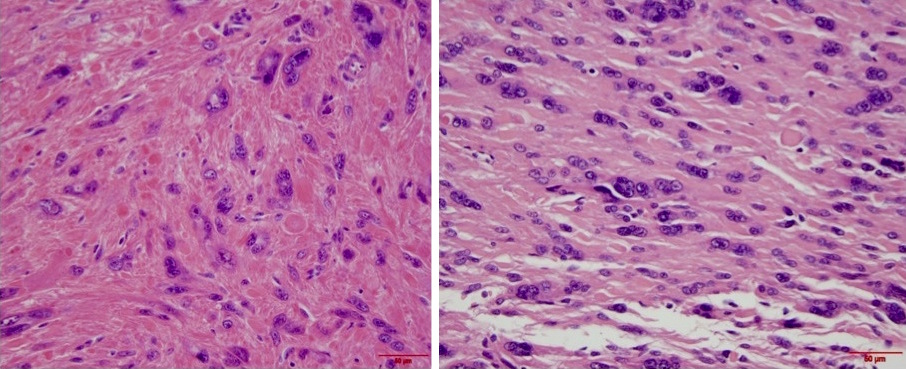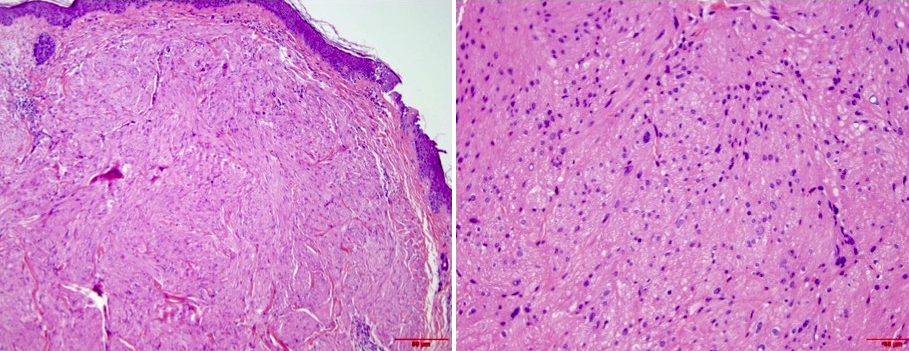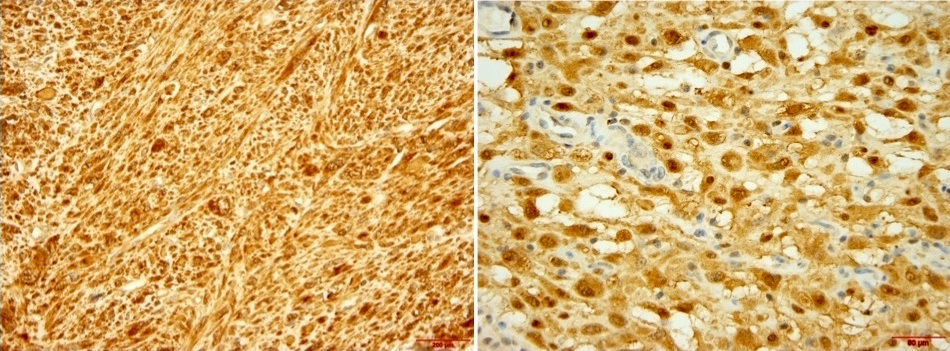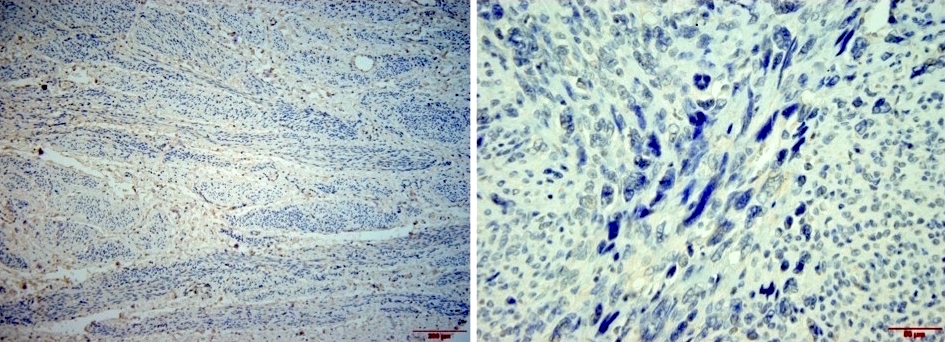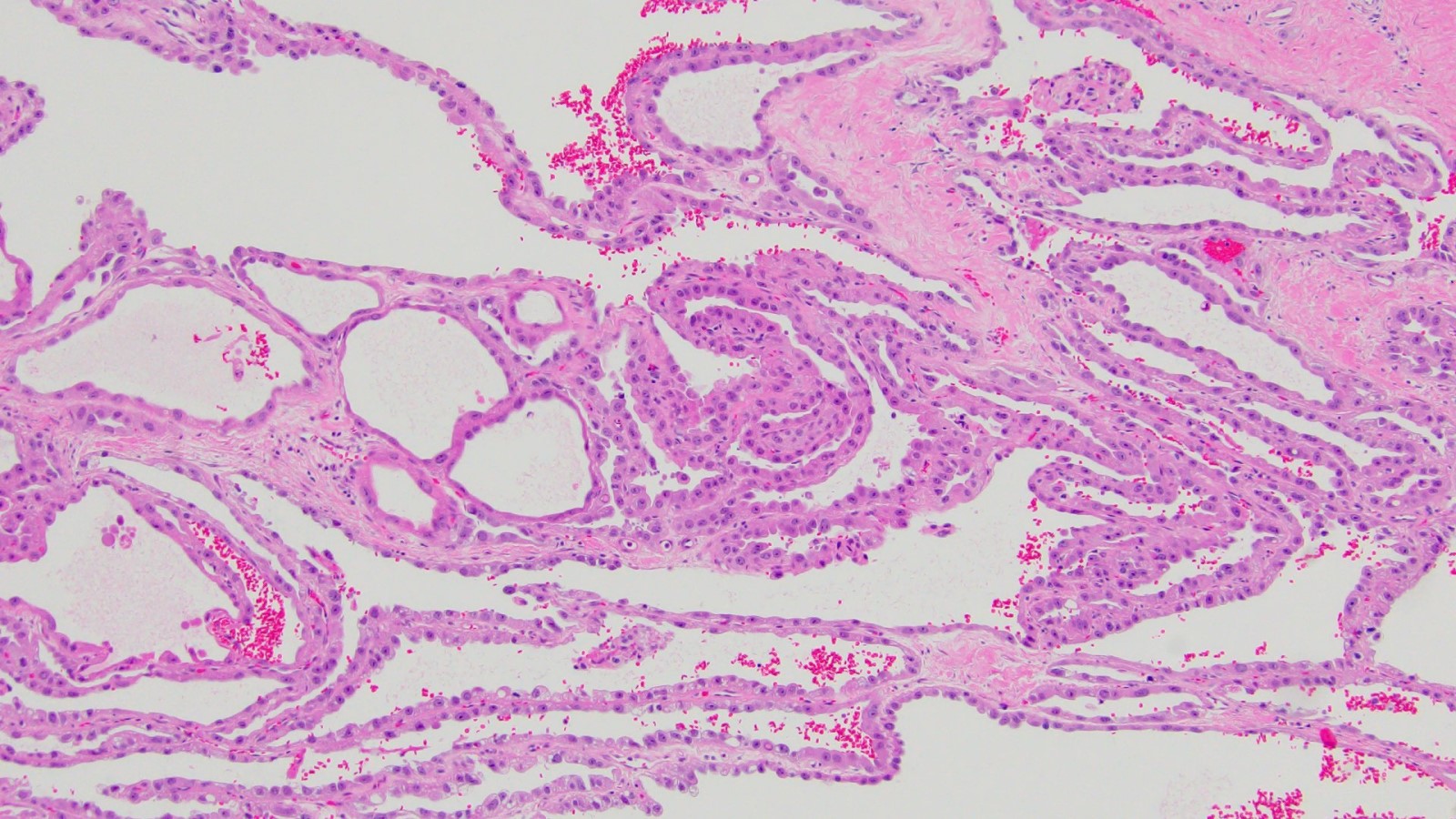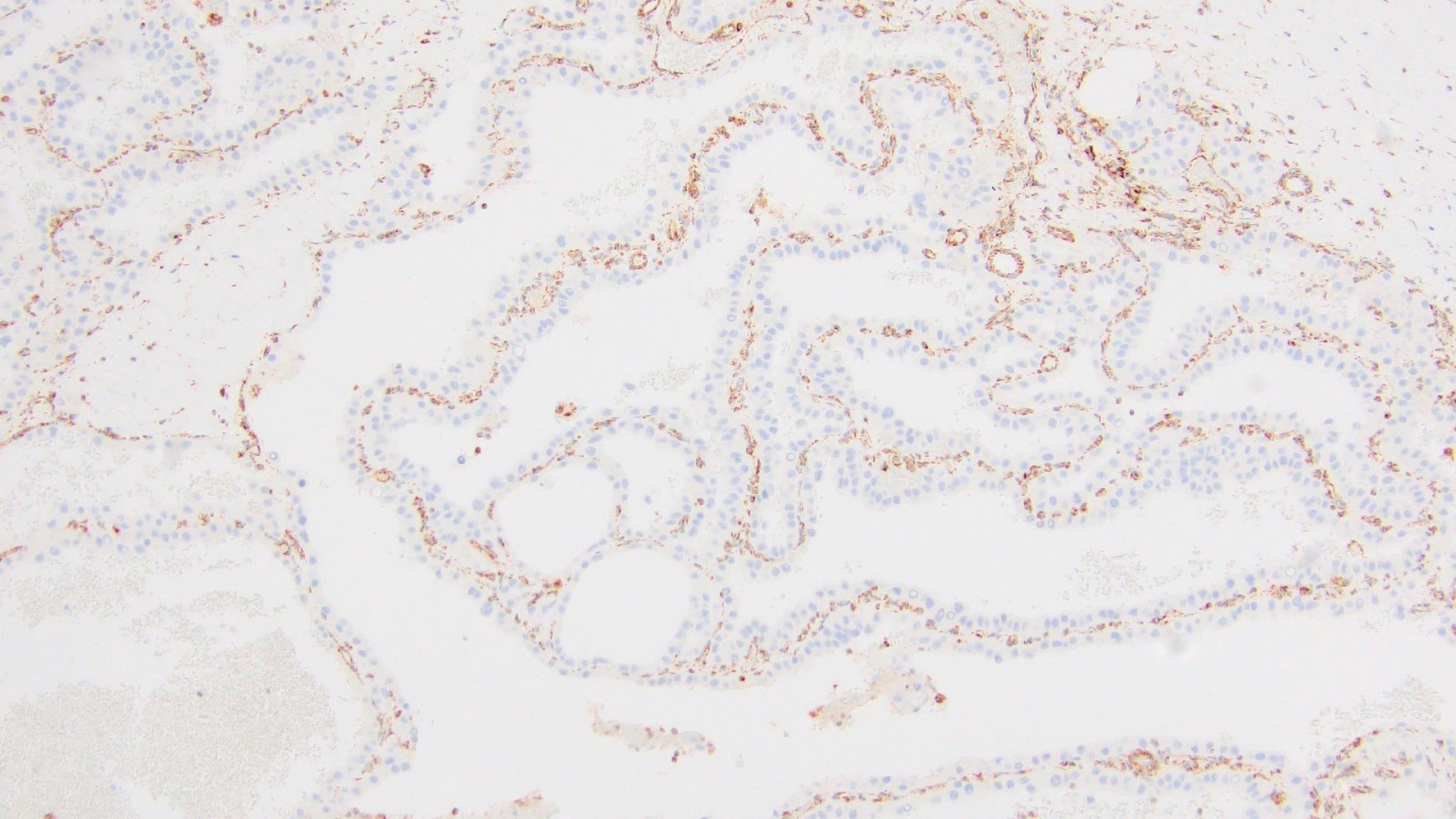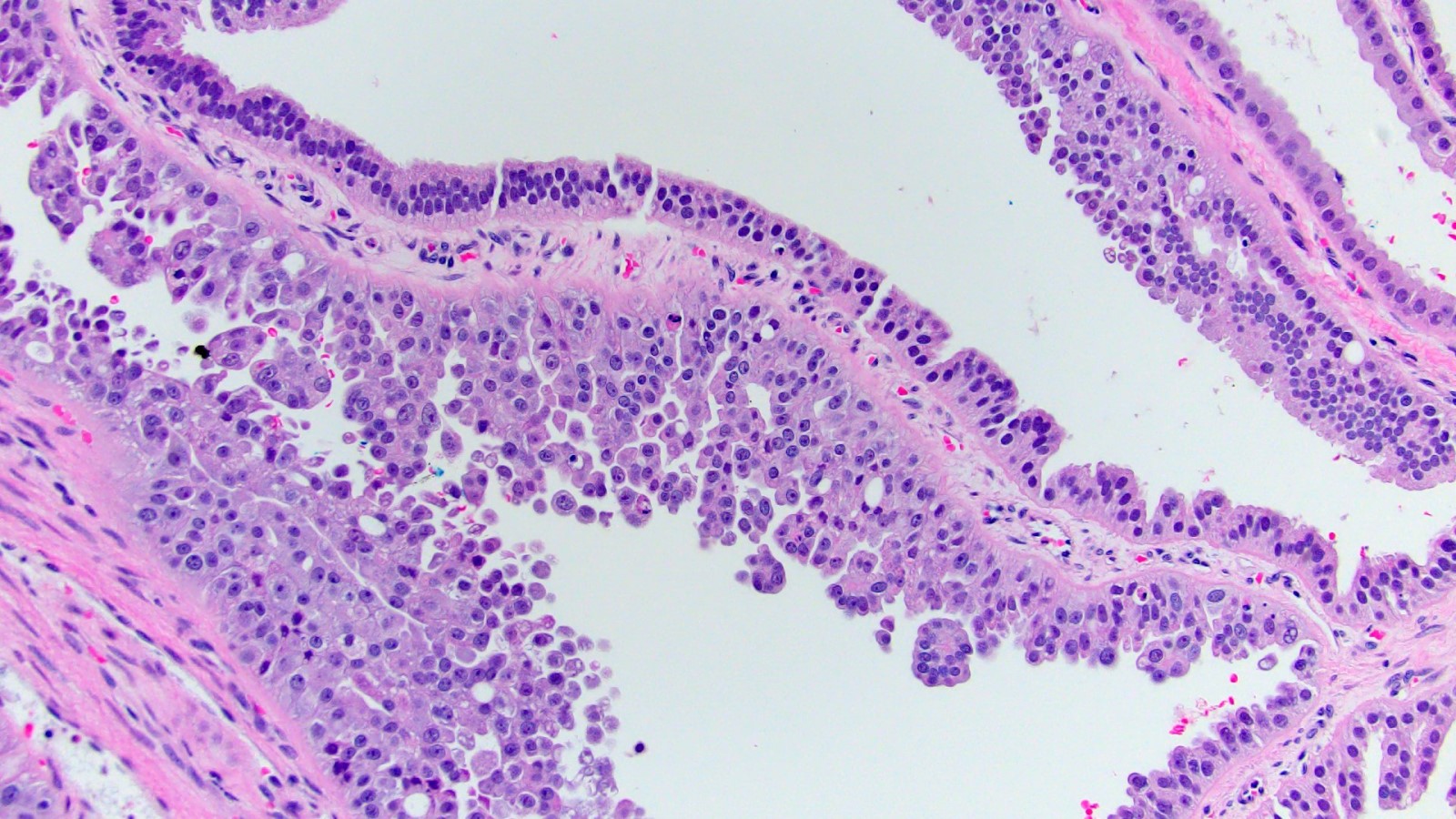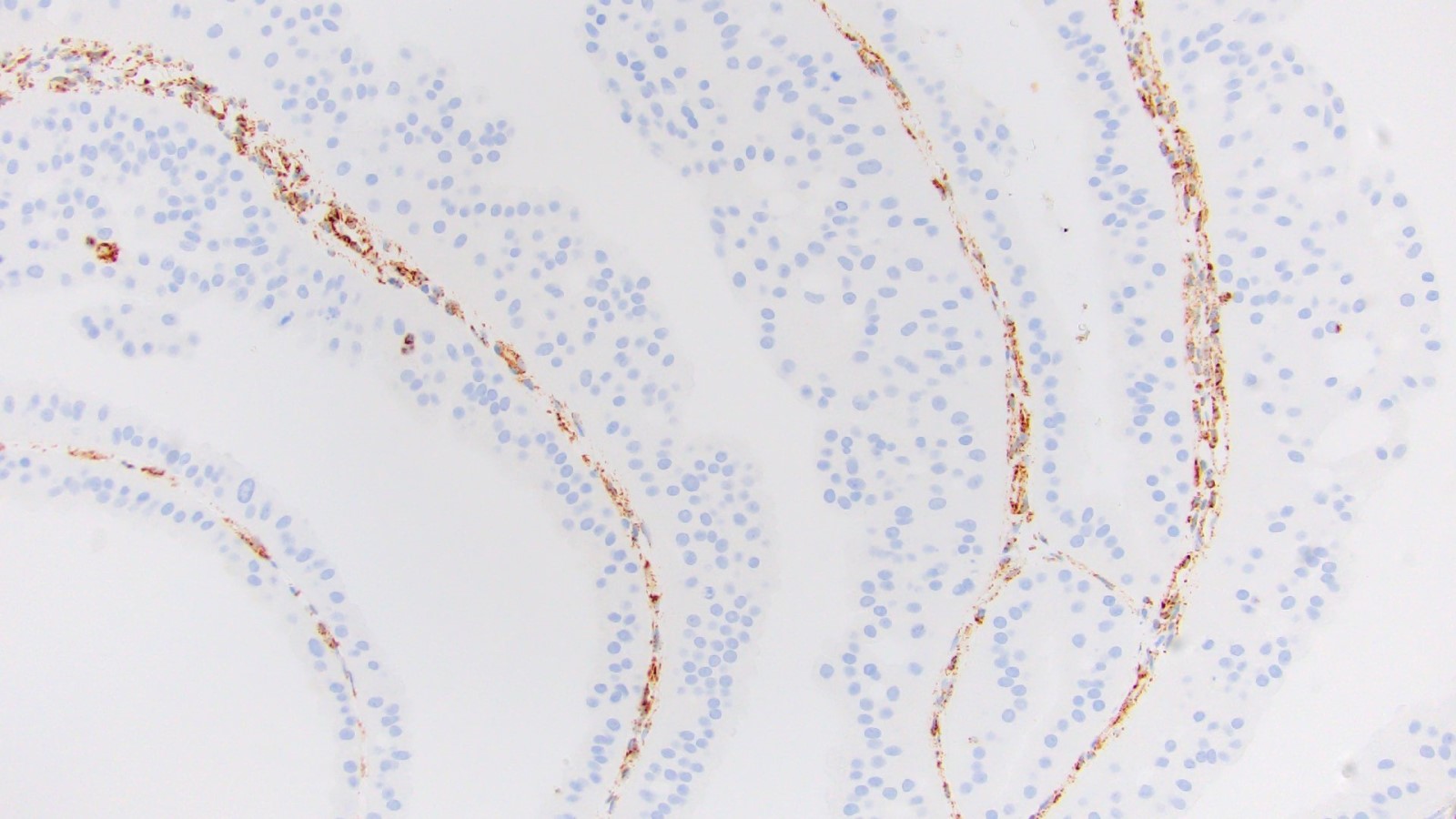Table of Contents
Definition / general | Essential features | Terminology | Pathophysiology | Clinical features | Uses by pathologists | Prognostic factors | Microscopic (histologic) description | Microscopic (histologic) images | Positive stains | Negative stains | Molecular / cytogenetics description | Molecular / cytogenetics images | Additional references | Board review style question #1 | Board review style answer #1Cite this page: Wei JJ. Fumarate Hydratase (FH), S-(2-succino) cysteine (2SC). PathologyOutlines.com website. https://www.pathologyoutlines.com/topic/stainsFH2SC.html. Accessed March 30th, 2025.
Definition / general
- Fumarate Hydratase (FH) is an enzyme that catalyzes the reversible hydration / dehydration of fumarate to malate
- S-(2-succino) cysteine (2SC) is a chemical modification of proteins and increases when biallelic FH is inactivated
- 2SC is a sensitive marker in detecting defective FH enzyme function
- FH is available commercially for clinical use but 2SC is not
Essential features
- Complete loss of immunoreactivity for FH and diffuse immunopositivity for 2SC are reliable biomarkers for detection of tumors with biallelic inactivation of FH
Terminology
- FH: fumarate hydratase
- 2SC: S-succino cysteine
- HLRCC: hereditary leiomyomatosis and renal cell carcinoma
- SMT-FH: smooth muscle tumors with fumarate hydratase aberration
- LM-BN: leiomyoma with bizarre nuclei
Pathophysiology
- Fumarate hydratase is a metabolic enzyme which participates in the citric acid cycle or Krebs cycle
- It plays an important role allowing cells to use oxygen and generate energy
- It helps convert a molecule called fumarate to a molecule called malate
- Germline mutations or somatic biallelic inactivation of FH result in certain tumor development
Clinical features
- Germline mutations of FH are seen in hereditary renal cell carcinoma, leiomyomatosis, skin pillar leiomyoma and defined as renal cell carcinoma syndrome (HLRCC), also known as Reed syndrome (Am J Surg Pathol 2016;40:865)
- Somatic biallelic inactivation and loss of FH can also be seen in sporadic high grade papillary renal cell carcinoma (Am J Surg Pathol 2016;40:865), in leiomyoma with bizarre nuclei and rarely in usual type leiomyoma
- Biallelic inactivation / mutations of FH are seen in:
- 85% of hereditary leiomyomatosis and renal cell carcinoma cases (Curr Mol Med 2004;4:869)
- 100% of renal cell carcinoma with germline FH mutations (Am J Surg Pathol 2016;40:865)
- 19% of papillary renal cell carcinoma (Type II) have FH deficiency and 90% of FH deficiency RCC have FH mutations (Am J Surg Pathol 2016;40:865)
- 1% of unselected leiomyomas (Am J Surg Pathol 2016;40:599)
- 2.6% of leiomyomas in patients < 40 years old (Am J Surg Pathol 2015;39:1529)
- 37 - 52% of leiomyoma with bizarre nuclei (Int J Gynecol Pathol 2018;37:421, Am J Surg Pathol 2016;40:1661)
- Most leiomyomas with FH inactivation / loss have characteristic histologic features, defined as smooth muscle tumors with fumarate hydratase aberration, including high cellularity with eosinophilic macronucleoli, perinucleolar halos, eosinophilic cytoplasmic globules, neurilemmoma-like growth pattern and branching staghorn vessels (Int J Gynecol Pathol 2018;37:421, Am J Surg Pathol 2016;40:923, Mod Pathol 2014;27:1020)
- Using the two IHC stains in combination with FH mutational analysis appears to be an extremely reliable way to confirm FH alterations and diagnosis of hereditary leiomyomatosis and renal cell carcinoma
Uses by pathologists
- Differentiation of leiomyoma with bizarre nuclei from smooth muscle tumor with FH alteration (Int J Gynecol Pathol 2018;37:421, Am J Surg Pathol 2016;40:1661)
- Differentiation of usual type leiomyoma from smooth muscle tumors with FH alteration (Am J Surg Pathol 2016;40:599, Am J Surg Pathol 2015;39:1529)
- Identification of Reed syndrome or hereditary leiomyomatosis and renal cell carcinoma by detecting FH biallelic inactivation in skin pillar leiomyoma, uterine leiomyomatosis and renal cell carcinoma (Curr Mol Med 2004;4:869, Am J Surg Pathol 2014;38:627)
Prognostic factors
- FH deficient RCC (both somatic and germline mutations) tend to be more aggressive and worse outcome, demonstrated by its high rate of advanced stage, positive nodes, and distant metastases (Am J Surg Pathol 2016;40:865)
- Germline mutations of FH portend a high risk of renal cell carcinoma as well as frequent skin and uterine leiomyoma at younger age (Am J Surg Pathol 2014;38:627)
- Most smooth muscle tumors with FH alterations seem to be acquired or somatic FH inactivation / mutations (Am J Surg Pathol 2016;40:599)
- Detection of FH deficient RCC by immunostain for FH/2SC can provide prognostic value
Microscopic (histologic) description
- SMT-FH leiomyomas:
- Tumors have relatively distinct histology and nuclear features characteristic by large and small round or oval nuclei, smooth nuclear membranes, prominent / macro nucleoli with perinucleolar halos
- They show areas of neurilemmoma like growth pattern, eosinophilic hyaline globules and staghorn vessels
- HLRCC:
- Tumors show mixed architectural patterns, with papillary, tubular, tubulopapillary, solid and cystic structures
- Hallmark of HLRCC demonstrate large eosinophilic nucleolus surrounded by a clear halo
Microscopic (histologic) images
Positive stains
- FH immunopositivity: strong and diffuse staining (dot-like and granular) in cytoplasm and mitochondria (Int J Gynecol Pathol 2018;37:421)
- FH Positive staining: normal myometrium and tumors without FH alteration
- 2SC immunopositivity: strong and diffuse staining (block-like) in cytoplasm and nucleus for 2SC (Int J Gynecol Pathol 2018;37:421)
- 2SC Positive staining: in tumors with biallelic inactivation of FH
Negative stains
- FH immunonegativity: a complete absence of immunoreactivity in tumor cells
- Immunopositivity for FH in vessels (endothelial cells and intima) can be used as internal positive control for stain
- FH Negative staining: tumors with biallelic inactivation of FH, including FH related renal cell carcinoma, skin leiomyoma and uterine leiomyoma
- 2SC immunonegativity: a complete absence of immunoreactivity in tumor cells
- 2SC Negative staining: normal myometrium and tumors without FH alteration
Molecular / cytogenetics description
- Fumarate hydratase gene is located in 1q43 and consists of 10 exons
- HLRCC follows an autosomal dominant inheritance pattern; this means that a parent with a FH gene mutation may pass along a copy of the gene with the mutation and it requires a second hit of FH alterations (somatic point mutation, or deletion) for renal cell carcinoma or leiomyomatosis
- Fumarate hydratase mutations have been found in all exons with frequent mutations commonly found in exon 7
- Based on one study, somatic fumarate hydratase point mutations account for over 40% of smooth muscle tumors with fumarate hydratase aberration with biallelic inactivation of FH and remainder tumors may be related to FH gene deletion (Int J Gynecol Pathol 2018;37:421)
- In addition, many FH-SMT with biallelic inactivation of FH can be caused by chromosome deletion in 1q (see below molecular image)
- Germline mutation can be found in almost all hereditary leiomyomatosis and renal cell carcinoma (Am J Surg Pathol 2014 38:627)
Additional references
- Ann Hum Genet 2008;72:35,
Acta Derm Venereol 2008;88:63,
Biochim Biophys Acta 2008;1782:287,
Mol Cell Biol 2009;29:4080,
BMC Res Notes 2009;2:194,
Hum Mol Genet 2010;19:3844,
Cancer Res 2010;70:9153,
PLoS One 2011;6:e21037,
Cancer Cell 2011;20:315,
Cancer Genet 2012;205:377,
Cell Rep 2013;3:1440,
PLoS One 2013;8:e72179,
Dermatol Pract Concept 2011;1:25,
Cancer Cell 2014;26:840,
Cancer Res 2016;76:5743,
Chin J Cancer 2016;35:72,
Am J Surg Pathol 2016;40:1457,
Histopathology 2017;71:42,
Am J Surg Pathol 2017;41:801,
Mol Cell Biol 2017;37:e00079,
Int J Gynecol Pathol 2018;37:256,
BMC Med Genet 2017;18:79,
Cancer Sci 2018;109:2757
Board review style question #1
- Biallelic inactivation of fumarate hydratase (FH) is associated with which of the following:
- Exclusively present in germline mutation
- Hereditary leiomyomatosis and renal cell carcinoma
- Intravenous leiomyomatosis
- Loss of both FH and 2SC by immunohistochemical stain
Board review style answer #1

